Simplified version —
Saturday, March 11, 2023
Law Play
Thursday, March 9, 2023
Meditation on a URL:
Putting the “de” in
https://www.hu-berlin.de/
From other posts tagged Tetrahedron vs. Square —
A Scholium for Chomsky —
The ABC of words —

A nutshell —
Putting the “de” in
https://www.hu-berlin.de/
Wednesday, February 15, 2023
Mathematics and Narrative . . .
Mathematics:
From Log24 "Pyramid Game" posts —
The letter labels, but not the tetrahedron, are from Whitehead’s
The Axioms of Projective Geometry (Cambridge U. Press, 1906), page 13.
Narrative:
Friday, February 3, 2023
Rhyme Time
From Wednesday, St. Bridget's Day, 2023 —
Poetic meditation from The New Yorker today —
"If the tendency of rhyme, like that of desire,
is to pull distant things together
and force their boundaries to blur,
then the countervailing force in this book,
the one that makes it go, is the impulse
toward narrative, toward making sense of
the passage of time."
Wednesday, May 25, 2022
Mexico City Blues
The New York Times yesterday ("2022-05-24T21:54:19.000Z")
on a Saturday, May 21, death —
"Colin Cantwell, an animator, conceptual artist and computer expert
who played significant production roles in seminal science fiction films
like '2001: A Space Odyssey,' 'Star Wars' and 'WarGames,' died
on May 21 at his home in Colorado Springs, Colo. He was 90."
Cantwell at Teotihuacan pyramid, September 26, 2019 —
A different image, also from September 26, 2019,
in other Log24 posts tagged Pyramid Game —
The letter labels, but not the tetrahedron, are from Whitehead’s
The Axioms of Projective Geometry (Cambridge U. Press, 1906),
page 13.
Wednesday, February 17, 2021
Raiders of the Lost Coordinates . . .
From other posts tagged Tetrahedron vs. Square —
"There is such a thing as a 4-set."
— Saying adapted from a 1962 young-adult novel.
Illustration (central detail a from the above tetrahedral figure) —
A Harvard Variation
from Timothy Leary —
The topics of Harvard and Leary suggest some other cultural
history, from The Coasters — "Poison Ivy" and "Yakety Yak."
Tuesday, December 29, 2020
Raiders of the Lost Coordinates
Wednesday, October 23, 2019
Art-Historical Narrative*
"Leonardo was something like what we now call a Conceptual artist,
maybe the original one. Ideas — experiments, theories — were
creative ends in themselves."
— Holland Cotter in the online New York TImes this evening
From other Log24 posts tagged Tetrahedron vs. Square —
* Phrase from the previous post, "Overarching Narrative."
Overarching Narrative
In memory of a retired co-director of Galerie St. Etienne
who reportedly died on October 17 . . .
"It is… difficult to mount encyclopedic exhibitions
without an overarching art-historical narrative…."
— Jane Kallir, director of Galerie St. Etienne, in
https://www.tabletmag.com/jewish-arts-and-culture/
visual-art-and-design/269564/the-end-of-middle-class-art
An overarching narrative from the above death date —
See as well the previous post
and "Dancing at Lughnasa."
Thursday, October 17, 2019
Dance of the Fire Temple
The previous post, Tetrahedron Dance, suggests a review of . . .
A figure from St. Patrick's Day 2004 that might
represent a domed roof …
Inscribed Carpenter's Square:

In Latin, NORMA
… and a cinematic "Fire Temple" from 2019 —

In related news . . .
Related background: "e. e. cummings" in this journal.
Tetrahedron Dance
Wednesday, October 9, 2019
The Joy of Six
Note that in the pictures below of the 15 two-subsets of a six-set,
the symbols 1 through 6 in Hudson's square array of 1905 occupy the
same positions as the anticommuting Dirac matrices in Arfken's 1985
square array. Similarly occupying these positions are the skew lines
within a generalized quadrangle (a line complex) inside PG(3,2).


Related narrative — The "Quantum Tesseract Theorem."
Monday, October 7, 2019
Oblivion
(A sequel to Simplex Sigillum Veri and
Rabbit Hole Meets Memory Hole)
" Wittgenstein does not, however, relegate all that is not inside the bounds
of sense to oblivion. He makes a distinction between saying and showing
which is made to do additional crucial work. 'What can be shown cannot
be said,' that is, what cannot be formulated in sayable (sensical)
propositions can only be shown. This applies, for example, to the logical
form of the world, the pictorial form, etc., which show themselves in the
form of (contingent) propositions, in the symbolism, and in logical
propositions. Even the unsayable (metaphysical, ethical, aesthetic)
propositions of philosophy belong in this group — which Wittgenstein
finally describes as 'things that cannot be put into words. They make
themselves manifest. They are what is mystical' " (Tractatus 6.522).
— Stanford Encyclopedia of Philosophy , "Ludwig Wittgenstein"
|
From Tractatus Logico-Philosophicus by Ludwig Wittgenstein.
(First published in Annalen der Naturphilosophie ,1921. 5.4541 The solutions of the problems of logic must be simple, since they set the standard of simplicity. Men have always had a presentiment that there must be a realm in which the answers to questions are symmetrically combined — a priori — to form a self-contained system. A realm subject to the law: Simplex sigillum veri. |
Somehow, the old Harvard seal, with its motto "Christo et Ecclesiae ,"
was deleted from a bookplate in an archived Harvard copy of Whitehead's
The Axioms of Projective Geometry (Cambridge U. Press, 1906).
In accordance with Wittgenstein's remarks above, here is a new
bookplate seal for Whitehead, based on a simplex —

Saturday, October 5, 2019
Friday, September 27, 2019
Algebra for Schoolgirls
The 15 points of the finite projective 3-space PG(3,2)
arranged in tetrahedral form:
The letter labels, but not the tetrahedral form,
are from The Axioms of Projective Geometry , by
Alfred North Whitehead (Cambridge U. Press, 1906).
The above space PG(3,2), because of its close association with
Kirkman's schoolgirl problem, might be called "schoolgirl space."
Screen Rant on July 31, 2019:
A Google Search sidebar this morning:
Apocalypse Soon! —
Thursday, September 26, 2019
Personalities …
For Dan Brown
“It’s a combination of elation and fear, a certain kind of terror,”
Dr. Scott-Warren, a lecturer at Cambridge University, said
Thursday [Sept. 19] in an interview, describing his feelings.
“As a scholar, you get a sense of the fixed landmarks,” he said.
“Suddenly to have a new landmark to come right up through
the ground is quite disconcerting; there’s something alarming
about that.”
Wednesday, September 25, 2019
Language Game
Previous posts now tagged Pyramid Game suggest …
A possible New Yorker caption: " e . . . (ab) . . . (cd) . "
Caption Origins —
Playing with shapes related to some 1906 work of Whitehead:
Tuesday, September 24, 2019
Emissary
|
Thursday, September 12, 2019
Tetrahedral Structures
|
Playing with shapes related to some 1906 work of Whitehead:
Saturday, September 21, 2019
Annals of Random Fandom
For Dan Brown fans …

… and, for fans of The Matrix, another tale
from the above death date: May 16, 2019 —
An illustration from the above
Miracle Octad Generator post:

Related mathematics — Tetrahedron vs. Square.
Saturday, September 14, 2019
The All-Night Record Player
See "Politics of Experience" and "Blue Guitar."
Friday, September 13, 2019
Schoolgirl Space…
Thursday, September 12, 2019
Tetrahedral Structures
In memory of a Church emissary who reportedly died on September 4,
here is a Log24 flashback reposted on that date —
Related poetry —
"To every man upon this earth,
Death cometh soon or late.
And how can man die better
Than facing fearful odds,
For the ashes of his fathers,
and the temples of his gods…?"
— Macaulay, quoted in the April 2013 film "Oblivion"
Related fiction —

Thursday, August 15, 2019
Schoolgirl Space — Tetrahedron or Square?
The exercise in the previous post was suggested by a passage
purporting to "use standard block design theory" that was written
by some anonymous author at Wikipedia on March 1, 2019:

Here "rm OR" apparently means "remove original research."
Before the March 1 revision . . .

The "original research" objected to and removed was the paragraph
beginning "To explain this further." That paragraph was put into the
article earlier on Feb. 28 by yet another anonymous author (not by me).
An account of my own (1976 and later) original research on this subject
is pictured below, in a note from Feb. 20, 1986 —
On Steiner Quadruple Systems of Order 16
An image from a Log24 post of March 5, 2019 —
The following paragraph from the above image remains unchanged
as of this morning at Wikipedia:
"A 3-(16,4,1) block design has 140 blocks of size 4 on 16 points,
such that each triplet of points is covered exactly once. Pick any
single point, take only the 35 blocks containing that point, and
delete that point. The 35 blocks of size 3 that remain comprise
a PG(3,2) on the 15 remaining points."
Exercise —
Prove or disprove the above assertion about a general "3-(16,4,1)
block design," a structure also known as a Steiner quadruple system
(as I pointed out in the March 5 post).
Relevant literature —
A paper from Helsinki in 2005* says there are more than a million
3-(16,4,1) block designs, of which only one has an automorphism
group of order 322,560. This is the affine 4-space over GF(2),
from which PG(3,2) can be derived using the well-known process
from finite geometry described in the above Wikipedia paragraph.
* "The Steiner quadruple systems of order 16," by Kaski et al.,
Journal of Combinatorial Theory Series A Volume 113, Issue 8,
November 2006, pages 1764-1770.
Saturday, August 10, 2019
Schoolgirl Space* Revisited:
The Square "Inscape" Model of
the Generalized Quadrangle W(2)
Click image to enlarge.
* The title refers to the role of PG (3,2) in Kirkman's schoolgirl problem.
For some backstory, see my post Anticommuting Dirac Matrices as Skew Lines
and, more generally, posts tagged Dirac and Geometry.
Wednesday, July 17, 2019
The Artsy Quantum Realm
|
arXiv.org > quant-ph > arXiv:1905.06914 Quantum Physics Placing Kirkman's Schoolgirls and Quantum Spin Pairs on the Fano Plane: A Rainbow of Four Primary Colors, A Harmony of Fifteen Tones J. P. Marceaux, A. R. P. Rau (Submitted on 14 May 2019) A recreational problem from nearly two centuries ago has featured prominently in recent times in the mathematics of designs, codes, and signal processing. The number 15 that is central to the problem coincidentally features in areas of physics, especially in today's field of quantum information, as the number of basic operators of two quantum spins ("qubits"). This affords a 1:1 correspondence that we exploit to use the well-known Pauli spin or Lie-Clifford algebra of those fifteen operators to provide specific constructions as posed in the recreational problem. An algorithm is set up that, working with four basic objects, generates alternative solutions or designs. The choice of four base colors or four basic chords can thus lead to color diagrams or acoustic patterns that correspond to realizations of each design. The Fano Plane of finite projective geometry involving seven points and lines and the tetrahedral three-dimensional simplex of 15 points are key objects that feature in this study. Comments:16 pages, 10 figures Subjects:Quantum Physics (quant-ph) Cite as:arXiv:1905.06914 [quant-ph] (or arXiv:1905.06914v1 [quant-ph] for this version) Submission history
From: A. R. P. Rau [view email] |
See also other posts tagged Tetrahedron vs. Square.
Life in Palermo
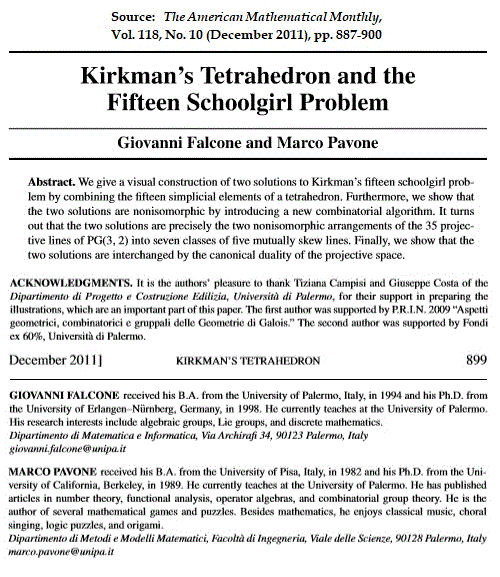
See also other posts tagged Tetrahedron vs. Square, and a related
Log24 search for "Schoolgirl + Space."
Saturday, July 13, 2019
Live from New York, It’s …
Curse of the Fire Temple
"Power outages hit parts of Manhattan
plunging subways, Broadway, into darkness"
Which Roof?
Related material — Tetrahedron vs. Square and Cézanne's Greetings.
Compare and contrast:
A figure from St. Patrick's Day 2004 that might represent a domed roof …
Inscribed Carpenter's Square:

In Latin, NORMA
… and a cinematic "Fire Temple" from 2019 —

Friday, July 12, 2019
Holloway Today
"The area is home to many artists and people who work in
the media, including many journalists, writers and professionals
working in film and television." — Wikipedia
Tusen takk to My Square Lady —
Tuesday, July 9, 2019
Perception of Space
The three previous posts have now been tagged . . .
Tetrahedron vs. Square and Triangle vs. Cube.
Related material —
Tetrahedron vs. Square:
Labeling the Tetrahedral Model (Click to enlarge) —
Triangle vs. Cube:

… and, from the date of the above John Baez remark —
Dreamtimes
“I am always the figure in someone else’s dream. I would really rather
sometimes make my own figures and make my own dreams.”
— John Malkovich at squarespace.com, January 10, 2017
Also on that date . . .
Monday, July 8, 2019
Exploring Schoolgirl Space

See also "Quantum Tesseract Theorem" and "The Crosswicks Curse."
Sunday, July 7, 2019
Schoolgirl Problem
Anonymous remarks on the schoolgirl problem at Wikipedia —
"This solution has a geometric interpretation in connection with
Galois geometry and PG(3,2). Take a tetrahedron and label its
vertices as 0001, 0010, 0100 and 1000. Label its six edge centers
as the XOR of the vertices of that edge. Label the four face centers
as the XOR of the three vertices of that face, and the body center
gets the label 1111. Then the 35 triads of the XOR solution correspond
exactly to the 35 lines of PG(3,2). Each day corresponds to a spread
and each week to a packing."
See also Polster + Tetrahedron in this journal.
There is a different "geometric interpretation in connection with
Galois geometry and PG(3,2)" that uses a square model rather
than a tetrahedral model. The square model of PG(3,2) last
appeared in the schoolgirl-problem article on Feb. 11, 2017, just
before a revision that removed it.
Saturday, December 17, 2016
Tetrahedral Death Star
Continuing the "Memory, History, Geometry" theme
from yesterday …
See Tetrahedral, Oblivion, and Tetrahedral Oblivion.
"Welcome home, Jack."
Saturday, December 10, 2016
Folk Etymology
Images from Burkard Polster's Geometrical Picture Book —

See as well in this journal the large Desargues configuration, with
15 points and 20 lines instead of 10 points and 10 lines as above.
Exercise: Can the large Desargues configuration be formed
by adding 5 points and 10 lines to the above Polster model
of the small configuration in such a way as to preserve
the small-configuration model's striking symmetry?
(Note: The related figure below from May 21, 2014, is not
necessarily very helpful. Try the Wolfram Demonstrations
model, which requires a free player download.)
Labeling the Tetrahedral Model (Click to enlarge) —
Related folk etymology (see point a above) —
Related literature —
The concept of "fire in the center" at The New Yorker ,
issue dated December 12, 2016, on pages 38-39 in the
poem by Marsha de la O titled "A Natural History of Light."
Cézanne's Greetings.
Thursday, September 15, 2016
The Smallest Perfect Number/Universe
The smallest perfect number,* six, meets
"the smallest perfect universe,"** PG(3,2).
* For the definition of "perfect number," see any introductory
number-theory text that deals with the history of the subject.
** The phrase "smallest perfect universe" as a name for PG(3,2),
the projective 3-space over the 2-element Galois field GF(2),
was coined by math writer Burkard Polster. Cullinane's square
model of PG(3,2) differs from the earlier tetrahedral model
discussed by Polster.

















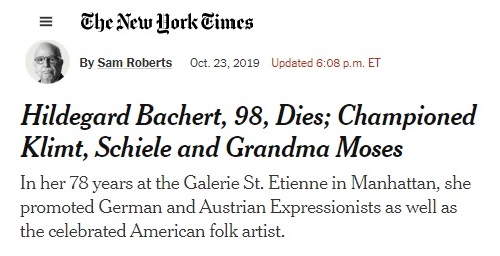
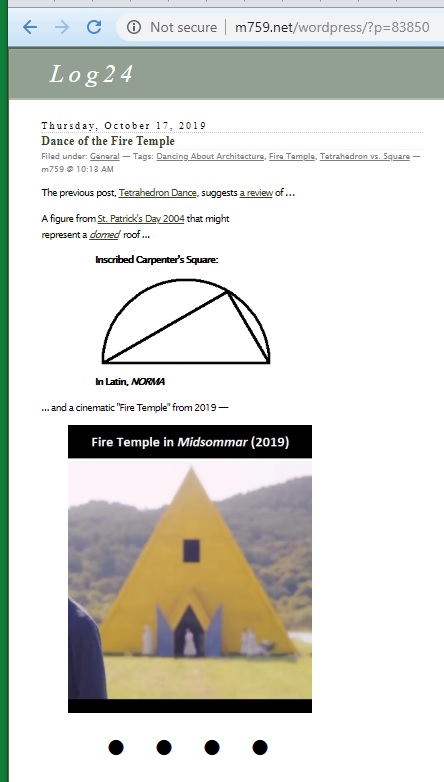



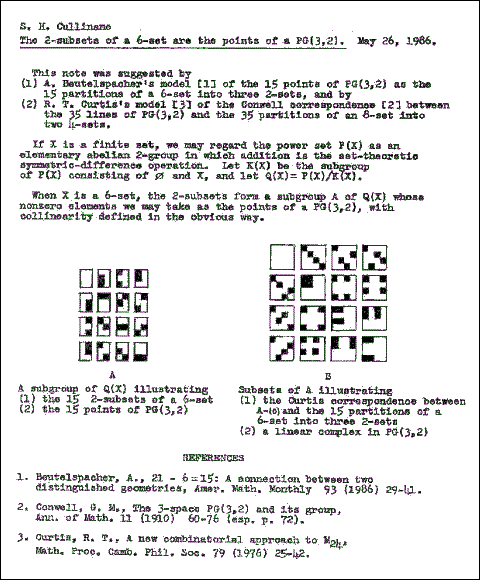










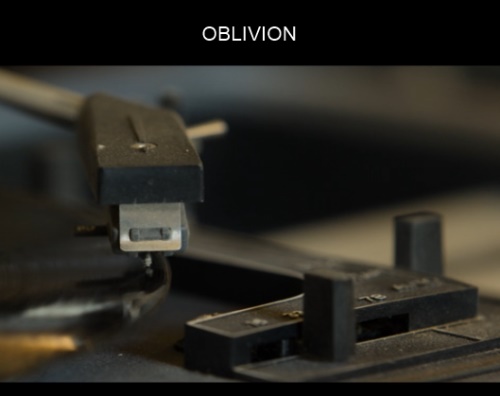





-embedding-in-PG(3,2)-Planat-Saniga.jpg)






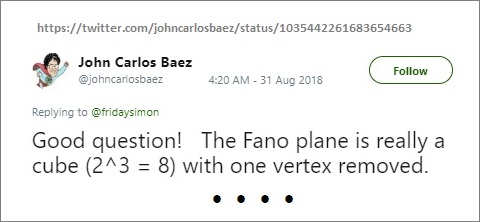




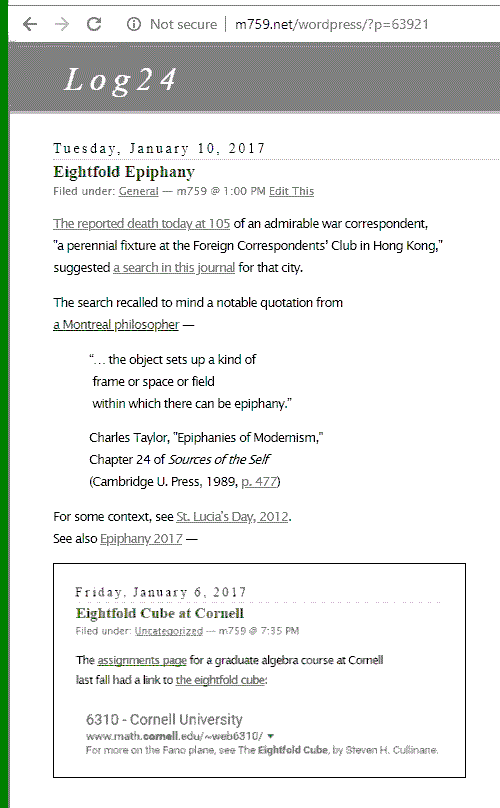 .
.


-Wolfram-410w.jpg)